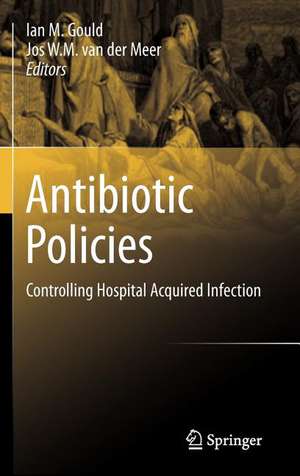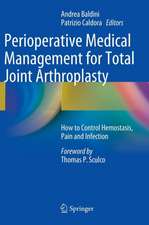Antibiotic Policies: Controlling Hospital Acquired Infection
Editat de Ian M. Gould, Jos W.M. van der Meeren Limba Engleză Hardback – 25 sep 2011
| Toate formatele și edițiile | Preț | Express |
|---|---|---|
| Paperback (3) | 973.39 lei 38-44 zile | |
| Springer – 7 dec 2014 | 973.39 lei 38-44 zile | |
| Springer Us – 18 noi 2010 | 981.05 lei 38-44 zile | |
| Springer Us – 29 oct 2010 | 1438.38 lei 6-8 săpt. | |
| Hardback (3) | 1097.18 lei 6-8 săpt. | |
| Springer – 25 sep 2011 | 1097.18 lei 6-8 săpt. | |
| Springer Us – 11 sep 2007 | 1102.46 lei 6-8 săpt. | |
| Springer Us – 17 sep 2004 | 1447.73 lei 6-8 săpt. |
Preț: 1097.18 lei
Preț vechi: 1154.93 lei
-5% Nou
Puncte Express: 1646
Preț estimativ în valută:
209.94€ • 228.77$ • 176.91£
209.94€ • 228.77$ • 176.91£
Carte tipărită la comandă
Livrare economică 23 aprilie-07 mai
Preluare comenzi: 021 569.72.76
Specificații
ISBN-13: 9781441917331
ISBN-10: 1441917330
Pagini: 300
Ilustrații: XIII, 209 p.
Dimensiuni: 155 x 235 x 20 mm
Greutate: 0.49 kg
Ediția:2012
Editura: Springer
Colecția Springer
Locul publicării:New York, NY, United States
ISBN-10: 1441917330
Pagini: 300
Ilustrații: XIII, 209 p.
Dimensiuni: 155 x 235 x 20 mm
Greutate: 0.49 kg
Ediția:2012
Editura: Springer
Colecția Springer
Locul publicării:New York, NY, United States
Public țintă
ResearchCuprins
Healthcare Associated Infections – The Size of the Problem.- The Antibiotic Paradox.- The Epidemiology of Pan/Extreme Drug Resistance.- Hospital Antibiotic Stewardship to Control Resistance - how should it be done?.- Controlling Clostridium difficile infection and the role of antibiotic stewardship.- The control of MRSA.- The role of antibiotic policies in controlling VRE.- The control of ESBL producing bacteria.- Controlling Hospital-Acquired Infection due to Carbapenem-Resistant Enterobacteriaceae (CRE).- Control of multi-drug resistant Acinetobacter infections.- The control of multidrug-resistant Pseudomonas: Insights into epidemiology and management.- Multidrug-resistant infections in low-resource health care settings.- Germ Shed Management in the United States.- Required actions.
Textul de pe ultima copertă
Hospitals worldwide are currently suffering an epidemic of infections, generated in and spreading in those instituitions whose very “raison d’etre” is to protect and improve the health of their patients. This paradox comes at a time of possibly unprecedented investment in preventative measures (infection control). To better control these infections, however, we need to understand their causes, many of which are related, paradoxically, to the success of antibiotic therapy. It is possible that the golden era of antibiotics led subconsciously to a loss of emphasis on the importance of hygiene in the control of HAI. Moreover, the majority of HAIs are due to multiply antibiotic resistant bacteria whose emergence has been hastened by over-enthusiastic antibiotic prescribing. Accumulating evidence also suggests that antibiotics not only select for resistance but can actually increase the numbers of HAIs and even their virulence.
This comprehensive compilation, written by eminent international researchers, explores these hypothesis in the context of recent epidemiology and evidence for the success of various antibiotic stewardship measures in controlling and even reversing resistance. It contains chapters by acclaimed authors on all the major causes of HAI, including MRSA, VRE, Clostridium difficile and multi resistant gram negative infections which are increasingly pan-resistant and untreatable; the nearest thing we have yet experienced to a “Doomsday bug”.
This book is an excellent source of information for students, researchers and practitioners in infection control, hospital epidemiology, antimicrobial prescribing and microbiology.
This comprehensive compilation, written by eminent international researchers, explores these hypothesis in the context of recent epidemiology and evidence for the success of various antibiotic stewardship measures in controlling and even reversing resistance. It contains chapters by acclaimed authors on all the major causes of HAI, including MRSA, VRE, Clostridium difficile and multi resistant gram negative infections which are increasingly pan-resistant and untreatable; the nearest thing we have yet experienced to a “Doomsday bug”.
This book is an excellent source of information for students, researchers and practitioners in infection control, hospital epidemiology, antimicrobial prescribing and microbiology.
Caracteristici
Explores the hypothesis that the increased use of antibiotics led subconsciously to a loss of emphasis on the importance of hygiene in the control of Hospital Acquired Infection
Contains chapters by acclaimed authors on all the major causes of Hospital Acquired Infection, including MRSA, VRE, Clostridium difficile and multi resistant gram negative infections which are increasingly pan-resistant and untreatable
Is an excellent source of information for students, researchers and practitioners in infection control, hospital epidemiology, antimicrobial prescribing and microbiology
Includes supplementary material: sn.pub/extras
Contains chapters by acclaimed authors on all the major causes of Hospital Acquired Infection, including MRSA, VRE, Clostridium difficile and multi resistant gram negative infections which are increasingly pan-resistant and untreatable
Is an excellent source of information for students, researchers and practitioners in infection control, hospital epidemiology, antimicrobial prescribing and microbiology
Includes supplementary material: sn.pub/extras
Descriere
Descriere de la o altă ediție sau format:
In 1971, I started a fellowship in infectious diseases and medical microbiology at the Channing Laboratory of the Harvard Medical Service at Boston City Hospital. My mentor, Dr. Maxwell Finland, had encouraged me to return there from the Center for Disease Control (as CDC was known then), where I had studied inf- tious diseases epidemiology and hospital-associated infection epidemiology, with the idea that we would review the demographic patterns of bacteremia and several other infections during Dr. Finland’s long tenure at the hospital. We did so, but I was surprised to find that he also invited me to help with the assessment of the success or failure of the programs to control antimicrobial use that he and c- leagues had put into place at the hospital over several years. The paper describing that review finally was published in 1974, after a long and tortuous process of review at several journals. Several reviewers felt that such attempts to improve use amounted to interference with the patient’s physician to do what was best. Others felt that such programs focused incorrectly on a subject other than treating the current patient. Fortunately, today, it is clear that antimicrobial resistance results in major part, but not entirely, from the ways that we use antimicrobial agents, and that the ov- all interests of patients in general, as well as those of society, are well served by efforts to use these drugs as well as possible.
In 1971, I started a fellowship in infectious diseases and medical microbiology at the Channing Laboratory of the Harvard Medical Service at Boston City Hospital. My mentor, Dr. Maxwell Finland, had encouraged me to return there from the Center for Disease Control (as CDC was known then), where I had studied inf- tious diseases epidemiology and hospital-associated infection epidemiology, with the idea that we would review the demographic patterns of bacteremia and several other infections during Dr. Finland’s long tenure at the hospital. We did so, but I was surprised to find that he also invited me to help with the assessment of the success or failure of the programs to control antimicrobial use that he and c- leagues had put into place at the hospital over several years. The paper describing that review finally was published in 1974, after a long and tortuous process of review at several journals. Several reviewers felt that such attempts to improve use amounted to interference with the patient’s physician to do what was best. Others felt that such programs focused incorrectly on a subject other than treating the current patient. Fortunately, today, it is clear that antimicrobial resistance results in major part, but not entirely, from the ways that we use antimicrobial agents, and that the ov- all interests of patients in general, as well as those of society, are well served by efforts to use these drugs as well as possible.










